 Imagine your ideal coworker or friend. She communicates well and is a good teammate. She’s in touch with her emotions but stays calm under pressure. She’s not a quitter. You’d probably describe her as hardworking, understanding, and flexible—the sort of person who helps solve big problems.
Imagine your ideal coworker or friend. She communicates well and is a good teammate. She’s in touch with her emotions but stays calm under pressure. She’s not a quitter. You’d probably describe her as hardworking, understanding, and flexible—the sort of person who helps solve big problems.
Research in economics, psychology, and sociology has found that, compared to people who are otherwise similar, those who demonstrate these sorts of mindsets and skills tend to have better outcomes in school and in life. Studies also show that contextual factors influence the degree to which people demonstrate these mindsets and skills. Supporting social-emotional development, such as by fostering experiences of belonging and promoting sharing and productive communication, has long been part of preschool and elementary school programs. Now, high schools increasingly are focused on social-emotional development, too.
The most common instruments used to measure social-emotional development are student surveys, in which adolescents report their experiences, behaviors, and attitudes related to school. Can these surveys reveal which high schools best support social-emotional development? And does attending such a school improve students’ long-term outcomes?
We examine results from a detailed annual survey about social-emotional development and school climate administered to students in the Chicago Public Schools. Through value-added analysis, we identify individual high schools’ impacts on 9th-grade students’ social-emotional development and test scores. We then trace the effects of attending a school that excels along each of these dimensions on short-term outcomes, such as absenteeism and school-based arrests, as well as on longer-term outcomes, like high-school graduation and college enrollment. Our focus on 9th grade is intentional, because it is a critical transition year of schooling, when young adolescents are most vulnerable to becoming off-track for high-school graduation due to accumulating an insufficient number of credits.
Our analysis confirms that some schools are better at supporting students’ social-emotional development than others. But these effects are not all the same. School effects cluster in two domains, social well-being and work habits, and some schools are better at one than at the other. Schools that promote social well-being have larger effects on students’ attendance and behavioral infractions, while those that improve work habits have larger effects on academic performance.
We also calculate each school’s value-added to student test scores and then look to see how well these measures predict student success. Compared to test-score value-added, social-emotional value-added is far more predictive of the behaviors that support student success, such as having fewer absences and being on-track to graduate. And it is more predictive of positive longer-run outcomes as well, such as graduating from high school and enrolling in a four-year college.
These results show that students’ own assessments of their social well-being and work habits provide valuable information about their development. They also show that these surveys can be used alongside traditional indicators like test scores to provide a more complete picture of how schools prepare students for the future. This analysis represents an important early step toward understanding how schools influence the social-emotional development of adolescents, how that can be measured, and how this can be useful for policy.
Surveying Social-Emotional Development
Chicago Public Schools is a large urban school district with 133 public high schools, including neighborhood, charter, vocational, and magnet schools. About 86 percent of students are from families with economic disadvantage. Forty-two percent of students are Black, and 44 percent are Latinx.
Since 2010–11, students in grades 6–12 have participated in an annual survey about their experiences previously known as My Voice, My School and now called the 5Essentials survey. The survey includes 21 questions designed to measure students’ social-emotional development, including their interpersonal skills, level of school connectedness, academic engagement, grit, and study habits. Students register their level of agreement on a numerical scale with statements like, “I’m good at working with other students,” “I don’t give up easily,” and “People here notice when I’m good at something” (see Figure 1). These questions assess students’ beliefs about themselves and their environments, both of which can influence learning.
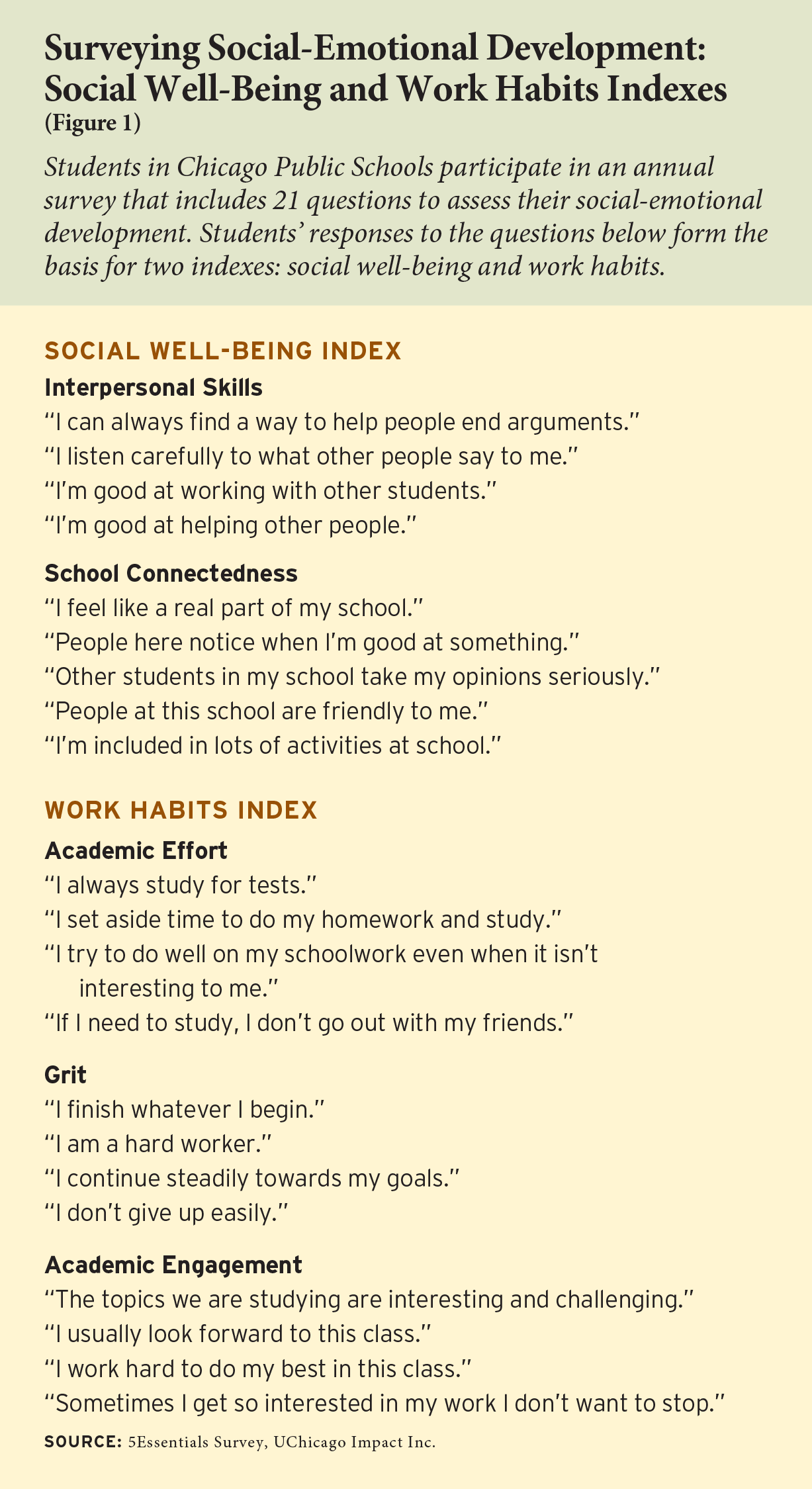
The most widely used theoretical framework for social-emotional learning, developed by the Collaborative for Academic, Social, and Emotional Learning, divides habits, mindsets, and skills into five domains. They are self-management, responsible decision-making, social-awareness, self-awareness, and relationship skills. Based on how students respond in our survey data cluster, however, we group questions into just two summary indexes. Questions about interpersonal relationships and school connections are sorted into a “social well-being” index, and questions regarding academic effort, academic engagement, and grit form a “work habits” index.
Our analysis uses administrative, test-score, and survey data for 157,630 students. We look mainly at cohorts of first-time 9th-grade students who attended high school between 2011 and 2017, which includes 55,560 students who are now old enough to have attended college. Some 78 percent of students invited to take the survey responded.
We look at shorter-term and longer-term outcomes for each student. In the short term, outcomes include how many times they were absent, how many disciplinary incidents made them eligible for suspension, and whether they earned at least five full-year course credits and no more than one F for a semester of work in a core course in their first year of high school. This “freshmen on track” measure is used by the district and is a more accurate predictor of graduation than test scores or demographics. In 2018–19, 89 percent of 9th-grade students in Chicago Public Schools were considered “on track.”
Another key outcome is whether a student has ever been arrested for activities conducted on school grounds, during off-campus school activities, or due to a referral by a school official. In Chicago, roughly 20 percent of juvenile arrests in 2010 were school based, so these arrests have important, long-term implications. During our sample period, 4 percent of Chicago public high-school students had a school-based arrest, including 5.3 percent of males and 7.9 percent of Black males.
In looking at longer-term outcomes, we consider high-school completion and college enrollment based on district and National Student Clearinghouse data. Overall, about 79 percent of first-time 9th graders in our sample went on to graduate high school, and about 53 percent enrolled in college within two years of their expected graduation date.
Estimating School Effects
Our analysis involves two key steps. First, we identify which schools add the most value to students’ social-emotional development and test scores. Then, we estimate the effects of attending those schools.
Our value-added model seeks to isolate the causal effects of individual schools on students’ test scores, social well-being, and work habits. We compare the test scores and survey responses of students at each school to similar students elsewhere at the end of 9th grade. To determine which students are similar, we look at a range of data gathered at the end of each student’s 8th-grade year: test scores, survey responses, course grades, discipline incidents, attendance, and demographics. The demographic characteristics we consider include students’ gender and ethnicity, the socioeconomic status of their Census block, and whether they qualify for free- or reduced-price school lunch. We calculate a school’s value-added by determining how much it increases students’ test scores and social-emotional development relative to the observed changes for similar students at other schools.
We then quantify the effects of attending a school with a value-added score in each domain—social well-being, work habits, and test scores—that is one standard deviation higher than the average school in our study. This is roughly equivalent to attending a school in the 85th percentile of performance in that domain rather than the average school.
We estimate these school effects two different ways. First, we simply ask whether students do better when they attend a school with high value-added in each separate domain. We then look at the predicted gains from attending a school that has high value-added in all three domains. This second approach reveals whether knowing a school’s value-added to social-emotional development provides additional information, over what is already evident from value-added to test scores, about how well the school supports student success.
Impacts on Social Well-Being
First, we look at how the high-school students attend affects their self-reported levels of social well-being while in 9th grade. When students attend high schools that demonstrated high value-added to social well-being in other school years, students’ reports of their own social well-being increase by 9 percent of a standard deviation compared to students attending the average school. Those students are more likely to agree that they are noticed when they are good at something, can end arguments among others, and are included in activities. This result provides compelling evidence that schools can, and do, influence students’ self-reported social well-being.
Schools with high value-added to work habits also improve students’ self-reported social well-being. In this case, the increase is 6.2 percent of a standard deviation compared to students in the average school. The effect on social well-being of attending a school with high test-score value-added is also positive but smaller, at 3.8 percent of a standard deviation.
What happens when we consider different aspects of school performance in combination with one another? An increase of one standard deviation across all three dimensions of performance leads to a 9.1 percent increase in students’ reports of their social well-being, almost identical to the gain from an increase in value-added to social well-being alone. In other words, the measure of value-added to social well-being captures virtually all of the detectable variation in school impacts on self-reported social well-being. Compared to test-score value-added, the inclusion of the two measures of social-emotional development more than doubles our ability to predict a school’s effects on social well-being.
Impacts on Work Habits
We then turn to school impacts on students’ self-reported work habits. When students attend a school with a track record of high work-habits value-added, their own work habits in 9th grade improve by 6.4 percent of a standard deviation. These students are more likely to agree that they try to do their best, study even when a subject doesn’t interest them, and finish what they start.
As with social well-being, we investigate the extent to which other aspects of a school’s performance predict positive effects on students’ persistence and hard work. A school with high value-added to social well-being has effects of 6 percent of a standard deviation, while a school with higher test-score value-added has an impact of 3.3 percent of a standard deviation.
In looking at these aspects of school performance in combination, we find that an increase of one standard deviation across all three dimensions increases work habits by 6.7 percent of a standard deviation. A school’s track record in developing students’ work habits is the best predictor of its success in boosting effort and grit among current students.
Impacts on Test Scores
How do these novel measures of school performance predict effects on student test scores? Intriguingly, the two measures of value-added to social-emotional development are nearly as good predictors of impacts on test scores as a school’s test-score value-added. Attending a school with strong test-score value-added increases 9th-grade test scores by 6.8 percent of a standard deviation (see Figure 2). Both social-emotional value-added measures have similar effects on test scores when considered on their own: 6 percent of a standard deviation for value added to social well-being and 5.7 percent for work habits value-added.
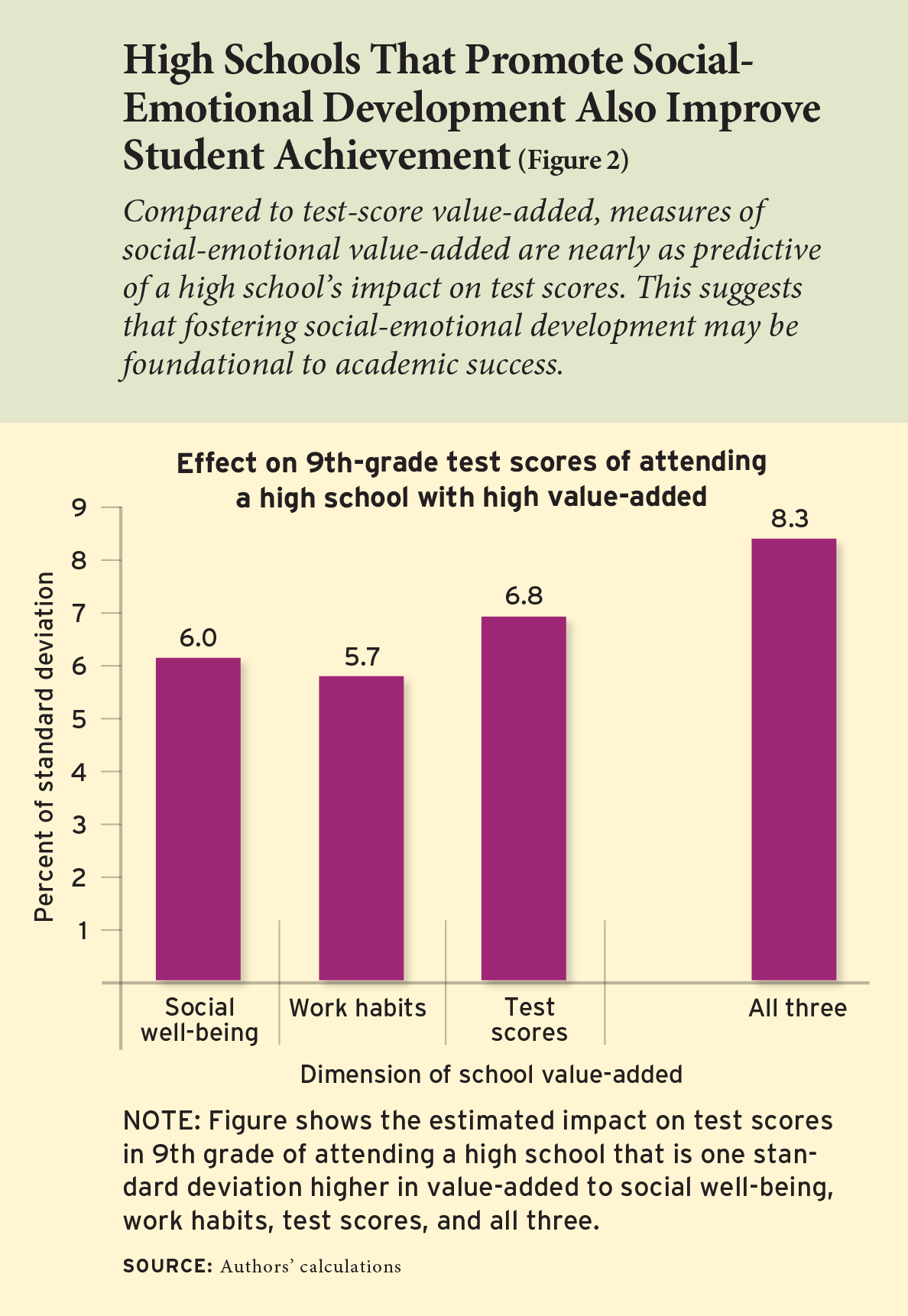
Considering these value-added estimates in combination reveals a remarkable result: measures of social-emotional value-added substantially improve our ability to predict a school’s impacts on test scores. Relative to using the test-score value-added measure alone, adding the two social-emotional value-added measures increases the share of the variation in students’ test scores that we can explain based on the school they attend by 47 percent. This stands in stark contrast to the pattern for social well-being and work habits, for which the vast majority of a school’s effect is captured by the estimates of the school’s value-added within those domains. In other words, schools that raise test scores don’t necessarily focus on academic achievement alone; fostering social-emotional development may be foundational for academic success.
This alone is revealing. But from a policy perspective, the key question is whether a school’s effectiveness in supporting students’ social-emotional development has implications for their success over the long haul. We explore this below.
Long-Term Impacts
At schools with higher value-added to social-emotional development, students are more likely to go on to graduate high school and enroll in a four-year college (see Figure 3). Both the social well-being and work habits value-added measures are stronger predictors of long-term school impacts than test score value-added.
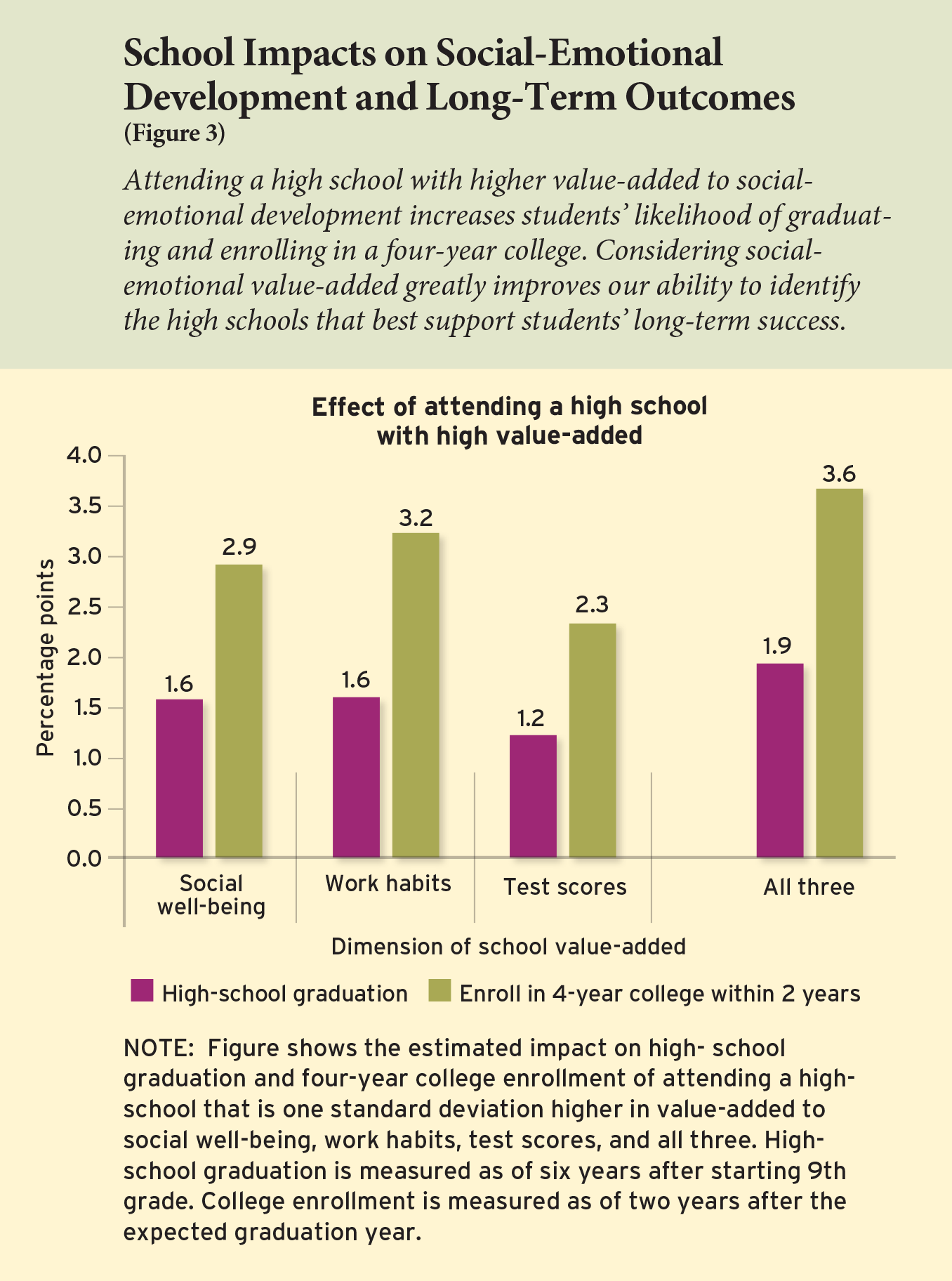
An increase of one standard deviation in the test-score value-added of the high-school students attend in 9th grade increases their likelihood of graduating from high school by about 1.2 percentage points. The impact is larger for increases in the school’s value-added to social-emotional development, at 1.6 percentage points for both social well-being and work habits value-added. Attending a school that has high value-added in all three domains increases the likelihood of graduating by 1.9 percentage points, a substantial jump compared to the gains from attending a high school with high test-score value-added alone.
We then turn to students’ college-going and look at whether students enroll in any college within two years of their expected high-school graduation date. We see the same pattern: social-emotional value-added measures are more predictive than test-score value-added for college attendance, as well. An increase of one standard deviation in test-score value-added increases college-going by 1.7 percentage points. For value-added to social well-being, the impact is 1.7 percentage points, and for work-habits value-added, it’s 2 percentage points. In considering all three value-added measures together, the predicted gain in student college-going is 2.3 percentage points. As with high-school completion, social-emotional value-added estimates predict more of the differences across schools in college-going rates than do estimates of value-added to test scores.
To delve deeper into the college results, we explore impacts on enrollment in both two-year and four-year schools. We find no effects of our value-added measures on enrollment in two-year schools, but we find large effects on four-year college-going. An increase of one standard deviation in test-score value-added boosts four-year college-going by 2.3 percentage points. The increase for value-added to social well-being is larger at 2.9 percentage points, and that for work-habits value-added is largest at 3.2 percentage points. Looking at all three value-added measures in combination, the increase in four-year college-going is 3.6 percentage points.
Potential Mechanisms
When more students report strong connections to school, healthy relationships, and the habits that support hard work, how does that play out in terms of their behavior? Does their high-school experience change in ways that could explain the positive longer-term outcomes we’ve just documented? We estimate the effects of high schools’ social-emotional value-added on three key metrics of student success in 9th grade: being on-track to graduate in four years, attendance, and the number of disciplinary incidents (see Figure 4).
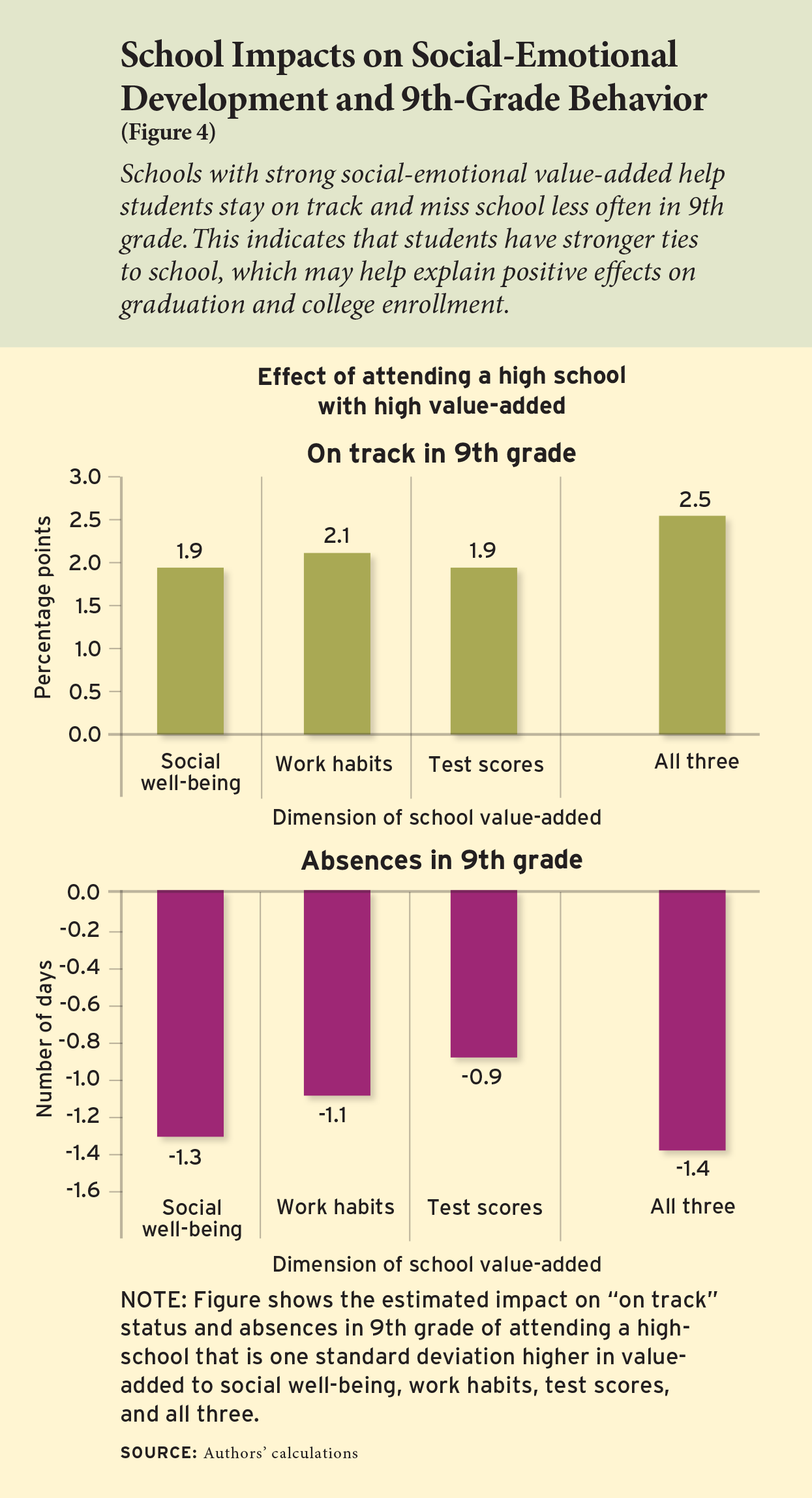
Schools with high social-emotional value-added have larger impacts on students’ on-track status than schools with high test-score value-added. A school that is one standard deviation higher in test-score value-added improves on-track rates by 1.9 percentage points. The gains from attending a school with high value-added to social well-being or work habits are 1.9 and 2.1 percentage points, respectively. A school that has high value-added across all three dimensions improves on-track rates by as much as 2.5 percentage points. This indicates that much of what high schools do to keep students on track to graduate is not captured by impacts on standardized tests. And it tells us that school impacts on self-reported survey measures capture more of a school’s impact on staying on track than impacts on test scores.
School attendance in 9th grade is another important predictor of high-school graduation. All three value-added measures predict absence rates, but value-added to social well-being, which reflects the strength of students’ connections to school and relationships with their peers, tells us more about how often a student will miss school than the other two. An increase of one standard deviation in a school’s test-score value-added reduces absences by 0.9 days in 9th grade. By comparison, an increase of one standard deviation in value-added to social well-being reduces absences by 1.3 days—roughly an 8.6 percent reduction compared to the average numbers of days a student is absent. This larger impact of value-added to social well-being is consistent with earlier findings that students who feel a greater sense of belonging are more likely to attend school.
Finally, we examine impacts on the number of disciplinary incidents in 9th grade and school-based arrests throughout high school. Both value-added to social well-being and test-score value-added predict fewer incidents, while work-habits value-added does not. An increase of one standard deviation in value-added to social well-being reduces the number of incidents by about 1 percentage point compared to 0.8 percentage points for test score value-added. Social-emotional value-added also has a greater effect and more predictive power than test scores when looking at school-based arrests. High value-added to social well-being reduces the likelihood of an arrest by 0.7 percentage points and high work-hard value-added leads to a reduction of 0.8 percentage points. Increasing test-score value-added reduces the likelihood of an arrest by 0.6 percentage points. Using all three value-added measures, the effect of attending a school that is stronger along all three dimensions is 0.9 percentage points. This represents a decrease of about 21 percent compared to the probability of a school-based arrest across all students.
Expanding the Definition of a “Good” School
The high-school years are formative, and attending a high-performing high school can build a foundation for success in adulthood. But what do we mean by high-performing? What are our metrics for success? Our study provides fresh answers to these enduring questions.
We find that some high schools are better than others at helping students develop healthy social lives, community connections, and the skills and habits that promote hard work and grit. We also find that students who attend such a school are more likely to experience positive outcomes in school and after graduation, from being more likely to attend a four-year college to having less interaction with the criminal-justice system. We focus our analysis on students in 9th grade. This transition year is an important window of opportunity to establish strong ties to school.
This is the first broad effort to validate measures of school impacts on social-emotional development that are based on self-report surveys, and our evidence shows that these estimates are arguably causal. Our finding that school impacts on social-emotional growth have larger effects on short- and long-term outcomes than schools’ impacts on test scores has important implications for how policymakers measure school quality.
We also show the potential for surveys to identify high-performing schools using more diverse indicators of success, at least in a low-stakes environment. Surveys reveal that schools that raise test scores are not always those that improve students’ social-emotional development, and vice versa. These results suggest that school quality is multidimensional and show that value-added estimates of impacts on social-emotional growth predict impacts on longer-term outcomes that are not captured by measures of a school’s value-added to test scores.
We conclude with a central question: which school practices improve social-emotional development? While much work remains to be done, our analysis represents an important early step toward a fuller picture of how schools influence student success.
C. Kirabo Jackson is the Abraham Harris Professor of Education and Social Policy at Northwestern University, where Sebastián Kiguel is a PhD student. Shanette C. Porter is director of research and a senior fellow at the Mindset Scholars Network. John Q. Easton is a senior fellow at the UChicago Consortium on School Research, where Alyssa Blanchard is a research analyst. This article is adapted from a study titled “School Effects on Socio-emotional Development, School-Based Arrests, and Educational Attainment,” forthcoming from American Economic Review: Insights.


 Imagine your ideal coworker or friend. She communicates well and is a good teammate. She’s in touch with her emotions but stays calm under pressure. She’s not a quitter. You’d probably describe her as hardworking, understanding, and flexible—the sort of person who helps solve big problems.
Imagine your ideal coworker or friend. She communicates well and is a good teammate. She’s in touch with her emotions but stays calm under pressure. She’s not a quitter. You’d probably describe her as hardworking, understanding, and flexible—the sort of person who helps solve big problems.








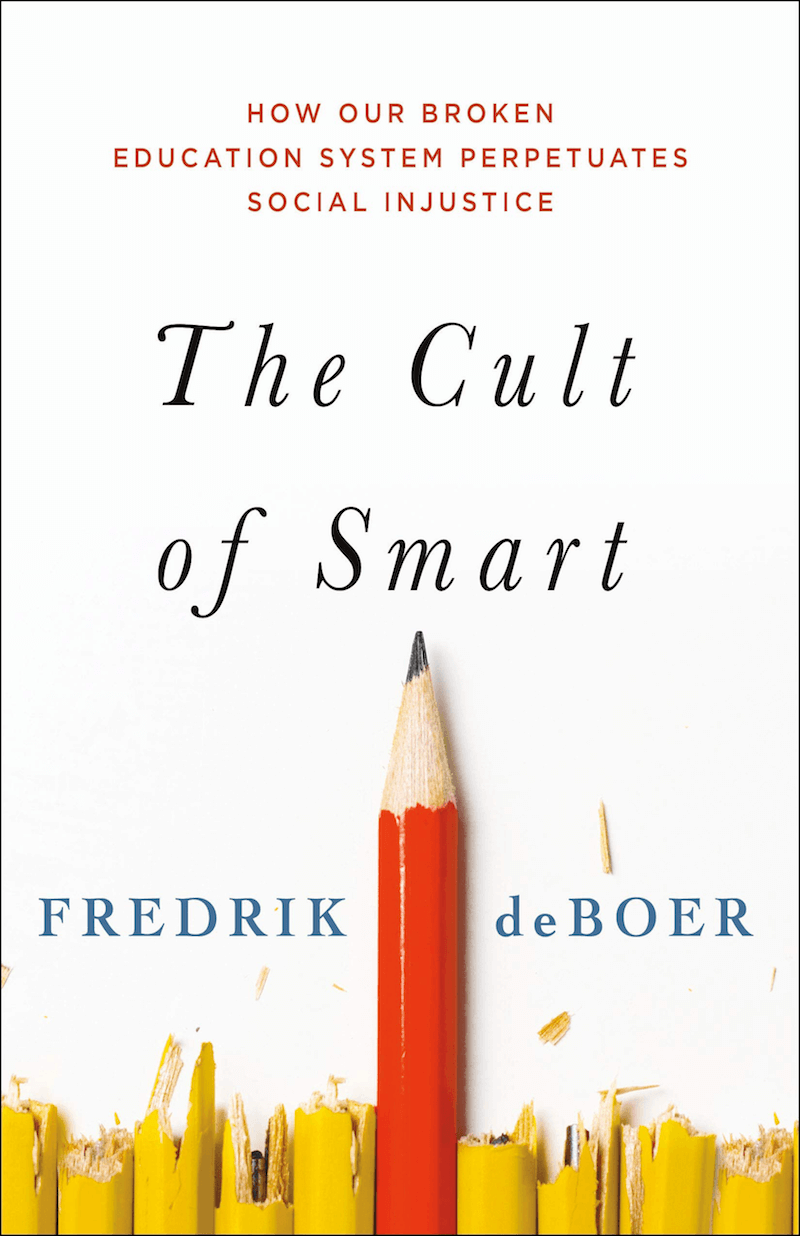 Much of the author’s argument rests on a shaky—even silly—caricature of the American meritocracy today. “The cult of smart,” deBoer explains, “is the notion that academic value is the only value, and intelligence the only true measure of human worth. It is pernicious, it is cruel, and it must change.”
Much of the author’s argument rests on a shaky—even silly—caricature of the American meritocracy today. “The cult of smart,” deBoer explains, “is the notion that academic value is the only value, and intelligence the only true measure of human worth. It is pernicious, it is cruel, and it must change.”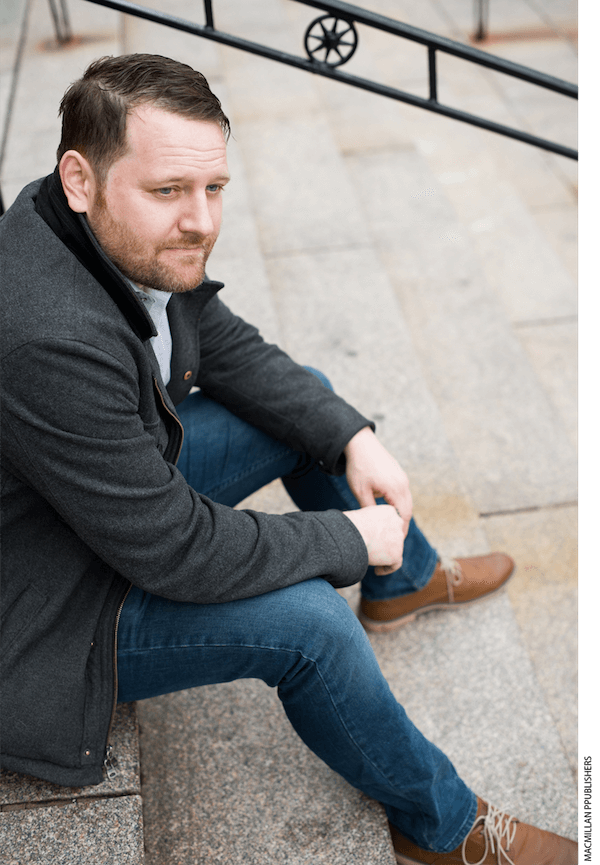
 An Associate Professor of Ecomonics at the Naval Postgraduate School, Ryan Sullivan, joins Paul E. Peterson to discuss Sullivan’s recent op-ed, which outlines why schools should resume in-person classes.
An Associate Professor of Ecomonics at the Naval Postgraduate School, Ryan Sullivan, joins Paul E. Peterson to discuss Sullivan’s recent op-ed, which outlines why schools should resume in-person classes.


